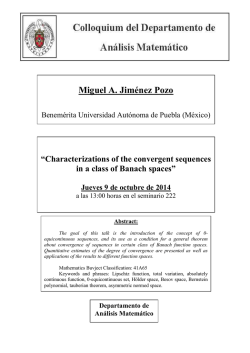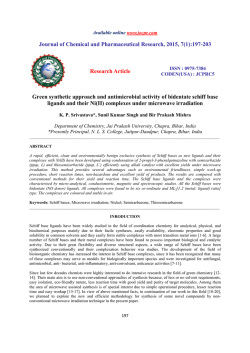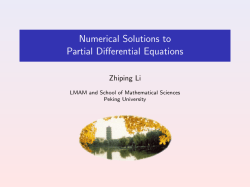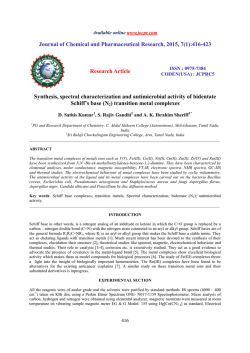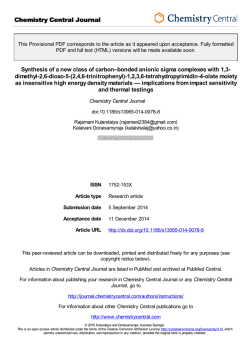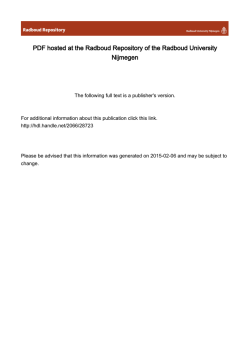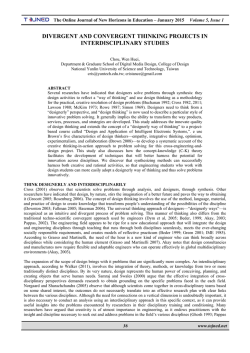
arXiv:1501.07540v1 [math.AT] 29 Jan 2015
arXiv:1501.07540v1 [math.AT] 29 Jan 2015
LUSTERNIK-SCHNIRELMANN CATEGORY OF
SIMPLICIAL COMPLEXES AND FINITE SPACES
´
´ AND J.A. VILCHES
D. FERNANDEZ-TERNERO,
E. MAC´IAS-VIRGOS,
Abstract. In this paper we establish a natural definition of Lusternik-Schnirelmann category for simplicial complexes via the well known
notion of contiguity. This category has the property of being homotopy
invariant under strong equivalences, and only depends on the simplicial
structure rather than its geometric realization.
In a similar way to the classical case, we also develop a notion of geometric category for simplicial complexes. We prove that the maximum
value over the homotopy class of a given complex is attained in the core
of the complex.
Finally, by means of well known relations between simplicial complexes and posets, specific new results for the topological notion of category are obtained in the setting of finite topological spaces.
Contents
1. Introduction
2. Preliminaries
2.1. Simplicial complexes
2.2. Finite topological spaces
2.3. Associated spaces and complexes
2.4. LS-category
3. LS-category of simplicial complexes
3.1. Simplicial category
3.2. Homotopical invariance
4. Geometric category
4.1. Simplicial geometric category
4.2. Behaviour under strong collapses
5. LS-category of finite spaces
5.1. Maximal elements
5.2. Geometric category
2
4
4
5
5
6
7
7
7
9
9
10
11
11
11
Date: January 30, 2015.
2010 Mathematics Subject Classification. 55U10, 55M30, 06F30 .
Key words and phrases. simplicial complex, contiguity class, strong collapse, LusternikSchnirelmann category, finite topological space, poset.
The first and the third authors are partially supported by PAIDI Research Groups
FQM-326 and FQM-189. The second author was partially supported by MINECO Spain
Research Project MTM2013-41768-P and FEDER.
1
2
´
´ AND J.A. VILCHES
D. FERNANDEZ-TERNERO,
E. MAC´IAS-VIRGOS,
6. Relation between categories
Acknowledgements
References
14
16
16
1. Introduction
Lusternik-Schnirelmann category was originally introduced as a tool for
variational problems on manifolds. Nowadays it has been reformulated as
a numerical invariant of topological spaces and has become an important
notion in homotopy theory and many other areas [4], as well as in applications like topological robotics [7]. Many papers have appeared on this
topic and the original definition has been generalized in a different number
of ways. For simplicial complexes and simplicial maps, the notion of contiguity is considered as the discrete version of homotopy. However, although
these notions are classical ones, the corresponding theory of LS-category is
missing in the literature. This paper can be consider as a first step in this
direction.
Still more important, finite simplicial complexes play a fundamental role
in the so-called theory of poset topology, which connects combinatorics to
many other branches of mathematics [9, 13]. Being more precise, such theory
allows to establish relations between simplicial complexes and finite topological spaces. On one hand, finite T0 -spaces and finite partially ordered
sets are equivalent categories (notice that any finite space is homotopically
equivalent to a T0 -space). On the other hand, given a finite topological
space X there exists the associated simplicial complex K(X), where the
simplices are its non-empty chains; and, conversely, given a finite simplicial
complex K there is a finite space χ(K), the poset of simplices of K, such
that K(χ(K)) = sd K, the first barycentric subdivision of K (in general, K
and sd(K) may not have the same strong homotopy type). These constructions allow to see posets and simplicial complexes as essentially equivalent
objects.
In this work we introduce a natural notion of LS-category scat K for
simplicial complexes. Unlike other topological notions established for the
geometric realization of the complex, our approach is directly based on the
simplicial structure. In this context, contiguity classes are the combinatorial
analogues of homotopy classes. For instance, different simplicial approximations to the same continuous map are contiguous. The geometric realizations
of contiguous maps are homotopic.
Analogously as the classical setting, it is desirable that this notion of category be a homotopy invariant. In order to obtain this goal, the notion of
strong collapse introduced by Minian and Barmak [2] is used instead of the
classical notion of collapse. The existence of cores or minimal complexes is
LS-CATEGORY OF SIMPLICIAL COMPLEXES AND FINITE SPACES
3
a fundamental difference between strong homotopy types and simple homotopy types. A simplicial complex can collapse to non-isomorphic subcomplexes. However if a complex K strongly collapses to a minimal complex K0 ,
it must be unique, up to isomorphism. We prove the homotopical invariance
of simplicial category, and, in particular, that scat K = scat K0 .
In addition, a notion of geometric category gscat K is introduced in the
simplicial context. For topological spaces geometric category is not a homotopical invariant, so it is customary to consider the minimum value of gcat Y ,
for all spaces Y of the same homotopy type as X. This process leads to a
homotopical invariant, Cat X, first introduced by Ganea [4]. In the simplicial context we prove some results about the behaviour of gscat K under
strong collapses. Other authors [1] have considered a notion of geometric
category for simple collapses. The essential difference is that for gcat one
can consider not only the minimum value in the homotopy class, but also
the maximum, which coincides with the category of the core of the complex.
By means of the equivalence between simplicial complexes and finite topological spaces, we get a notion of LS-category of finite spaces which corresponds with the classical notion, because the concept of strong homotopy
equivalence in the simplicial context corresponds to the notion of homotopy
equivalence in the setting of finite spaces. In other words, there is a correspondence between strong homotopy types of finite simplicial complexes
and homotopy types of finite spaces. Under this point of view new results
are obtained which have not analogous in the continuous case.
The authors consider this work as a foundational paper establishing new
notions that are worthy of further development.
The paper is organized as follows. We start by introducing in Section 2
the basic notions and results concerning the links between simplicial complexes and finite topological spaces, as well as the definition of classical
LS-category. Section 3 is focused on the study of the simplicial LS-category
scat K of a simplicial complex K. We prove that this notion is a homotopy
invariant, that is, two strong equivalent complexes have the same category.
The corresponding notion of geometrical category gcat K for a simplicial
complex K is studied in Section 4. We obtain that the geometrical category
increases under strong collapses, and that the maximum value is obtained
for the core K0 of the complex. Section 5 contains a study on the LScategory of finite topological spaces. Notice that it is not the LS-category of
the geometric realization |K(X)| of the associated simplicial complex, but
it is the category of the topological space X itself. We have not found any
specific study of LS-category for finite topological spaces. For instance, we
prove that the number of maximal elements minus one is an upper bound of
the category of a finite topological space. By analogy with the LS-category
of simplicial complexes we establish other results for finite spaces. In particular, in Section 6 we prove that both the category and the geometrical
category decrease when applying the functors K and χ. We conclude that
4
´
´ AND J.A. VILCHES
D. FERNANDEZ-TERNERO,
E. MAC´IAS-VIRGOS,
strong collapsibility and contractibility are equivalent in the corresponding
contexts.
2. Preliminaries
2.1. Simplicial complexes. We recall the notions of contiguity and strong
collapse. Let K, L be two simplicial complexes. Two simplicial maps ϕ, ψ : K →
L are contiguous [11, p. 130] if, given any simplex σ ∈ K, the set ϕ(σ)∪ψ(σ)
is a simplex of L. This relation, denoted by ϕ ∼c ψ, is reflexive and symmetric, but in general it is not transitive.
Definition 2.1. Two simplicial maps ϕ, ψ : K → L are in the same contiguity class, denoted by ϕ ∼ ψ, if there is a sequence
ϕ = ϕ0 ∼c · · · ∼c ϕn = ψ
of contiguous simplicial maps ϕi : K → L, 0 ≤ i ≤ n.
A simplicial map ϕ : K → L is a strong equivalence if there exists ψ : L →
K such that ψ ◦ ϕ ∼ idK and ϕ ◦ ψ ∼ idL . We write K ∼ L if there is a
strong equivalence between the complexes K and L. In the nice paper [3]
Barmak and Minian showed that strong homotopy types can be described
by a certain type of elementary moves called strong collapses. A detailed
exposition is in Barmak’s book [2].These moves are a particular case of the
well known notion of simplicial collapse [6].
Definition 2.2. A vertex v of a simplicial complex K is dominated by
another vertex v 0 6= v if every maximal simplex that contains v also contains
v0.
If v is dominated by v 0 then the inclusion i : K \ v ⊂ K is a strong
equivalence. Its homotopical inverse is the retraction r : K → K \ v which
is the identity on K \ v and such that r(v) = v 0 . This retraction is called an
elementary strong collapse from K to K \ v, denoted by K && K \ v.
A strong collapse is a finite sequence of elementary collapses. The inverse
of a strong collapse is called a strong expansion and two complexes K and L
have the same strong homotopy type if there is a sequence of strong collapses
and strong expansions that transform K into L.
Example 2.3. Figure 1 is an example of elementary strong collapse.
v
v0
v0
v0
Figure 1. Strong elementary collapse
LS-CATEGORY OF SIMPLICIAL COMPLEXES AND FINITE SPACES
5
The following result states that the notions of strong homotopy type and
strong equivalence (via contiguity) are the same.
Theorem 2.4. [3, Cor. 2.12] Two complexes K and L have the same strong
homotopy type if and only if K ∼ L.
2.2. Finite topological spaces. We are interested in homotopical properties of finite topological spaces. First, let us recall the correspondence
between finite posets and finite T0 -spaces. If (X, ≤) is a partially ordered
finite set, we consider the T0 topology on X given by the basis {Ux }x∈X
where
Ux = {y ∈ X : y ≤ x}.
Conversely, if (X, τ ) is a finite topological space, let Ux be the least open
set containing x ∈ X. Then we can define a preorder by saying x ≤ y if and
only if Ux ⊂ Uy . This preorder is an order if and only if τ is T0 . Under this
correspondence, a map f : X → Y between finite T0 -spaces is continuous if
and only if f is order preserving. Order spaces are also called “Alexandrov
spaces”.
Proposition 2.5. Any (finite) topological space has the homotopy type of a
(finite) T0 -space.
Proof. Take the quotient by the equivalence relation: x ∼ y if and only if
Ux = Uy .
From now on, we shall deal with finite spaces which are T0 .
Proposition 2.6. [14] The connected components of X are the equivalence
classes of the equivalence relation generated by the order.
We now consider the notion of homotopy. Let f, g : X → Y be two
continuous maps between finite spaces. We write f ≤ g if f (x) ≤ g(x) for
all x ∈ X.
Proposition 2.7. [3] Two maps f, g : X → Y between finite spaces are
homotopic, denoted by f ' g, if and only if they are in the same class of the
equivalence relation generated by the relation ≤ between maps.
Corollary 2.8. The basic open sets Ux ⊂ X are contractible.
Proof. Since x is a maximum of Ux , it is a deformation retract of Ux by
means of the constant map r = x : Ux → Ux .
2.3. Associated spaces and complexes. To each finite poset X it is
associated the so-called order complex K(X). It is the simplicial complex
with vertex set X and whose simplices are given by the finite non-empty
chains in the order on X. Moreover, if f : X → Y is a continuous map, the
associated simplicial map K(f ) : K(X) → K(Y ) is defined as K(f )(x) = f (x)
for each vertex x ∈ X.
6
´
´ AND J.A. VILCHES
D. FERNANDEZ-TERNERO,
E. MAC´IAS-VIRGOS,
Proposition 2.9. [2, Prop. 2.1.2, Th. 5.2.1]
(1) If f, g : X → Y are homotopic maps then the simplicial maps K(f )
and K(g) are in the same contiguity class.
(2) If two T0 -spaces X, Y are homotopy equivalent, then the complexes
K(X) and K(Y ) have the same strong homotopy type.
Notice that the reciprocal statements are not necessarily true, because
two non-homotopic maps f, g may induce maps K(f ), K(g) which are in the
same contiguity class, through simplicial maps which do not preserve order.
Conversely, it is possible to assign to any finite simplicial complex K its
Hasse diagram or face poset, that is, the poset of simplices of K ordered by
inclusion. If ϕ : K → L is a simplicial map, the associated continuous map
χ(ϕ) : χ(K) → χ(L) is given by χ(ϕ)(σ) = ϕ(σ), for any simplex σ of K.
Proposition 2.10. [2, Prop. 2.1.3, Th.5.2.1]
(1) If the simplicial maps ϕ, ψ : K → L are in the same contiguity class
then the continuous maps χ(ϕ), χ(ψ) are homotopic.
(2) If two finite simplicial complexes K, L have the same strong homotopy type, then the associated spaces χ(K), χ(L) are homotopy equivalent.
2.4. LS-category. We recall the basic definitions of Lusternik-Schnirelmann theory. Well known references are [4] and [8].
An open subset U of a topological space X is called categorical if U can
be contracted to a point inside the ambient space X. In other words, the
inclusion U ⊂ X is homotopic to some constant map.
Definition 2.11. The Lusternik-Schnirelmann category, cat X, of X is the
least integer n ≥ 0 such that there is a cover of X by n + 1 categorical open
subsets. We write cat X = ∞ if such a cover does not exist.
Category is an invariant of homotopy type. Another interesting notion,
the geometric category, denoted by gcat X, can be defined in a similar way
using subsets of X which are contractible in themselves, instead of contractible in the ambient space X. By definition, cat X ≤ gcat X. However,
geometric category is not a homotopy invariant [4].
Remark 1. For ANRs one can use closed covers, instead of open covers,
in the definition of LS-category. However, these two notions would lead
to different theories in the setting of finite spaces. For instance, for the
finite space of Example 5.2, we obtain different values for the corresponding
categories. This work is limited to the nowadays most common definition of
LS-category, that is, using categorical open subsets.
Remark 2. Actually, the definition of LS-category by covers is not well-suited
for many constructions in homotopy theory. This led to alternative definitions (Ganea, Whithead [4]) which are well known in algebraic topology.
However, those constructions require that the space X verifies some additional properties. One of them, the existence of non-degenerate base-points is
LS-CATEGORY OF SIMPLICIAL COMPLEXES AND FINITE SPACES
7
guaranteed by Prop. 2.8. But other properties, like being Hausdorff or even
normal, are not verified by finite spaces (notice that every finite T1 -space is
discrete), so we have not explored them further.
3. LS-category of simplicial complexes
We work in the category of finite simplicial complexes and simplicial maps
[11]. The key notion introduced in this paper is that of LS-category in the
simplicial setting, which is the natural one when the notion of “homotopy”
is that of contiguity class. Contiguous maps were considered in Subsection
2.1.
3.1. Simplicial category.
Definition 3.1. Let K be a simplicial complex. We say that the subcomplex
U ⊂ K is categorical if there exists a vertex v ∈ K such that the inclusion
i : U → K and the constant map cv : U → K are in the same contiguity
class, iU ∼ cv .
In other words, i factors through v up to “homotopy” (in the sense of contiguity class). Notice that a categorical subcomplex may not be connected.
Definition 3.2. The simplicial LS-category, scat K, of the simplicial complex K, is the least integer m ≥ 0 such that K can be covered by m + 1
categorical subcomplexes.
For instance, scat K = 0 if and only if K has the strong homotopy type
of a point.
Example 3.3. The simplicial complex K of Figure 2 appears in [3]. It is
collapsible (in the usual sense) but not strongly collapsible, then scat K ≥ 1.
We can obtain a cover by two strongly collapsible subcomplexes taking a non
internal 2-simplex σ and its complement K \ σ. Thus scat K = 1.
Figure 2. A complex K with scat K = 1.
3.2. Homotopical invariance. The most important property of the simplicial category is that it is an invariant of the strong equivalence type, as
we shall prove now.
Theorem 3.4. Let K ∼ L be two strong equivalent complexes.
scat K = scat L.
Then
´
´ AND J.A. VILCHES
D. FERNANDEZ-TERNERO,
E. MAC´IAS-VIRGOS,
8
We begin with two Lemmas which are easy to prove.
Lemma 3.5. Let f, g : K → L be two contiguous maps, f ∼c g, and let
i : N → K (resp. r : L → N ) be another simplicial map. Then f ◦ i ∼c g ◦ i
(resp. r ◦ f ∼c r ◦ g).
Lemma 3.6. Let
f1
fn
gn
g1
K = K0 → K1 → · · · → Kn = L
and
L = Kn → · · · → K1 → K0 = K
be two sequences of maps such that gi ◦ fi ∼c 1 and fi ◦ gi ∼c 1, for all
i ∈ {1, . . . , n}. Then the complexes K and L are strong equivalent, K ∼ L.
The main Theorem 3.4 will be a direct consequence of the following Proposition (by interchanging the roles of K and L).
Proposition 3.7. Let f : K → L and g : L → K be simplicial maps such
that g ◦ f ∼ 1K . Then scat K ≤ scat L.
Proof. Let U ⊂ L be a categorical subcomplex. Since the inclusion iU is
in the contiguity class of some constant map cv , there exists a sequence of
maps ϕi : U → K, 0 ≤ i ≤ n, such that
iU = ϕ0 ∼c · · · ∼c ϕn = cv .
Take the subcomplex f −1 (U ) ⊂ K. We shall prove that f −1 (U ) is categorical. Since g ◦ f ∼ 1K , there is a sequence of maps ψi : K → K, 0 ≤ i ≤ m,
such that
1K = ψ0 ∼c · · · ∼c ψm = g ◦ f.
Denote by f 0 the restriction of f to f −1 (U ), with values in U , that is,
f 0 : f −1 (U ) → U , defined by f 0 (x) = f (x). Denote by j : f −1 (U ) ⊂ K the
inclusion. Then:
(1)
j = 1K ◦ j = ψ0 ◦ j ∼c · · · ∼c ψm ◦ j = g ◦ f ◦ j
by Lemma 3.5. Since f ◦ j = iU ◦ f 0 , it is
(2)
g ◦ f ◦ j = g ◦ iU ◦ f 0 = g ◦ ϕ0 ◦ f 0 ∼c · · · ∼c g ◦ ϕn ◦ f 0 .
But ϕn = cv , then g ◦ ϕn ◦ f 0 : f −1 (U ) → g(U ) is the constant map cg(v) .
Combining (1) and (2) we obtain
j ∼ cg(v) .
Then the subcomplex f −1 (U ) ⊂ K is categorical.
Finally, let k = scat L and let {U0 , . . . , Uk } be a categorical cover of L;
then {f −1 (U0 ), . . . , f −1 (Uk )} is a categorical cover of K, which shows that
scat K ≤ k.
LS-CATEGORY OF SIMPLICIAL COMPLEXES AND FINITE SPACES
9
A core of a finite simplicial complex K is a subcomplex K0 ⊂ K without
dominated vertices, such that K && K0 [3]. Every complex has a core,
which is unique up to isomorphism, and two finite simplicial complexes have
the same strong homotopy type if and only if their cores are isomorphic.
Since scat is an invariant of the strong homotopy type (Theorem 3.4) we
have proved the following result.
Corollary 3.8. Let K0 be the core of the simplicial complex K. Then
scat K = scat K0 .
4. Geometric category
As in the classical case, we shall introduce a notion of simplicial geometric
category gscat in the simplicial setting, when “homotopy” means to be in
the same contiguity class. Another so-called discrete category, dcat, which
takes into account the notion of collapsibility instead of strong collapsibility,
has been considered by Scoville in [1]. But in contrast with the simplicial
LS-category introduced in Section 3, both gscat and dcat are not homotopy
invariant. The problem must then be override by taking the infimum of the
category values over all simplicial complexes which are homotopy equivalent
to the given one.
However, our geometric category possesses a remarkable property: due
to the notion of core complex explained before, there is also a maximum of
category among the complexes in a given homotopy class.
Remark 3. It is possible to do a translation of the notion of simple collapsibility to finite topological spaces, by means of the notion of weak beat point
[5].
4.1. Simplicial geometric category. According to the notion of strong
collapse (defined in Section 2), a simplicial complex K is strongly collapsible
if it is strongly equivalent to a point. Equivalently, the identity 1K is in the
contiguity class of some constant map cv : K → K.
Definition 4.1. The simplicial geometric category gscat K of the simplicial
complex K is the least integer m ≥ 0 such that K can be covered by m + 1
strongly collapsible subcomplexes. That is, there exists a cover U0 , . . . , Um ⊂
K of K such that Ui ∼ ∗ for all i ∈ {0, . . . m}.
Notice that strongly collapsible subcomplexes must be connected.
Proposition 4.2. scat K ≤ gscat K.
Proof. The proof is reduced to check that a strongly collapsible subcomplex
is categorical: in fact, the only difference is that in the first case the identity
1U is in the contiguity class of some constant map cv , while in the second it
is the inclusion iU : U → X that verifies iU ∼ cv .
10
´
´ AND J.A. VILCHES
D. FERNANDEZ-TERNERO,
E. MAC´IAS-VIRGOS,
4.2. Behaviour under strong collapses. Obviously, scat and gscat are
invariant by simplicial isomorphisms. Moreover we proved in Theorem 3.4
that scat is a homotopy invariant. Next Theorem shows that strong collapses
increase the geometric category.
Theorem 4.3. If L is a strong collapse of K then gscat L ≥ gscat K.
Proof. Without loss of generality we may assume that there is an elementary
strong collapse r : K → L = K \ v (see Definition 2.2). If i : L ⊂ K is the
inclusion, then r ◦ i = 1L while σ ∪ (i ◦ r)(σ) is a simplex of L, for any
simplex σ of K. Let V be a strongly collapsible subcomplex of L, that is,
the identity 1V is in the contiguity class of some constant map cw : V → V .
That means that there is a sequence of maps ϕi : V → V , 0 ≤ i ≤ n, such
that
1V = ϕ0 ∼c · · · ∼c ϕn = cw .
Let us denote r0 = r−1 (V ) → V the restriction of r to r−1 (V ), with values
in V . Analogously denote i0 : V → r−1 (V ) the inclusion (this is well defined
because r ◦ i = 1V ).
Then, by Lemma 3.5, ϕi ∼c ϕi+1 implies i0 ◦ ϕi ◦ r0 ∼c i0 ◦ ϕi+1 ◦ r0 . Clearly
i0 ◦ ϕn ◦ r0 = i0 ◦ cw ◦ r0 = ci(w)
is a constant map. On the other hand it is
i0 ◦ ϕ0 ◦ r0 = i0 ◦ 1V ◦ r0 = i0 ◦ r0
and the latter map is contiguous to 1r−1 (V ) . This is true because if σ is a
simplex of r−1 (V ) then it is a simplex of K, then σ ∪ (i ◦ r)(σ) is a simplex
of K, which is contained in r−1 (V ) because r ◦ i = 1V . But (i ◦ r)(σ) =
(i0 ◦ r0 )(σ), then σ ∪ (i0 ◦ r0 )(σ) is a simplex of r−1 (V ).
We have then proved that the constant map cw is in the same contiguity
class that the identity of r−1 (V ), which proves that the latter is strongly
collapsible.
Now, let m = gscat L and {V0 , . . . , Vm } a cover of L by strongly collapsible
subcomplexes. Then {r−1 (V0 ), . . . , r−1 (Vm )} is a cover of K by strongly
collapsible subcomplexes. This proves that gscat K ≤ m.
Given any finite complex K, by successive elimination of dominated vertices one obtains the core K0 of the complex K, which is the same for all the
complexes in the homotopy class of K. Then we have the following result
(compare with Corollary 3.8).
Corollary 4.4. The geometric category gscat K0 of the core K0 of the complex K is the maximum value of gscat L among all the complexes L which
are strongly equivalent to K.
LS-CATEGORY OF SIMPLICIAL COMPLEXES AND FINITE SPACES
11
5. LS-category of finite spaces
In this paper finite posets are considered as topological spaces by themselves, and not as geometrical realizations of its associated order complexes.
That is, as emphasized in [2, p. 34], to say that a finite T0 -space X is contractible is different that saying that |K(X)| is contractible (although X
and |K(X)| have the same weak homotopy type). In this context we shall
consider the usual notion of LS-category of topological spaces [4]. We have
already introduced it in Definition 2.11.
5.1. Maximal elements. The following result establishes an upper bound
for the category of a finite poset. Notice that there is not a result of this
kind for non-finite topological spaces
Proposition 5.1. Let M (X) be the number of maximal elements of X.
Then cat X ≤ gcat X < M (X).
Proof. If x ∈ X is a maximal element then Ux is contractible (Corollary 2.8),
so maximal elements determine a categorical cover.
In particular, a space with a maximum is contractible, as it is well known.
It is also known that if X has a unique minimal element x then X is
contractible, because the identity is homotopic to the constant map cx . Even
more, a space X is contractible if and only if its opposite space X op (that
is, reverse order) is contractible. However, the-LS categories of X and X op
may not coincide, as the following Example shows. This is a quick way to
check that X and X op are not homotopy equivalent, even if they always are
weak homotopy equivalent.
Example 5.2. In Figure 3 it is clear that cat X = 1 because X is not
contractible and cat X < 2 by Proposition 5.1. However cat X op = 2 since
catX op < 3 and it is easy to check that the unions of any two open sets
Uyi ∪ Uyj are not contractible.
x1
x2
y1
y2
y3
X
X OP
Figure 3. A space where cat X 6= cat X op .
Notice that for any categorical open cover, the open sets Ux corresponding
to maxima must be contained in some element of the cover.
5.2. Geometric category. As it was pointed out in Section 2, another
homotopy invariant, Cat X, can be defined as the least geometric category
of all spaces in the homotopy type of X. A peculiarity of finite topological
spaces is that it is also possible to consider the maximum value of gcat in
12
´
´ AND J.A. VILCHES
D. FERNANDEZ-TERNERO,
E. MAC´IAS-VIRGOS,
each homotopy type. We shall prove that this maximum is attained in the
so called core space of X, a notion introduced by Stong [12].
The next definition is equivalent to that of linear and colinear points in
[12, Th. 2], called beat points by other authors [2, 3, 10].
Definition 5.3. Let X be a finite topological space. A point x0 ∈ X is
a beat point if there exists another point x00 6= x0 verifying the following
conditions:
(1) If x0 < y then x00 ≤ y;
(2) if x < x0 then x ≤ x00 .
(3) x0 and x00 are comparable.
In other words, a beat point covers exactly one point or it is covered by
exactly one point. Figure 4 shows a beat point with x0 ≤ x00 .
x 00
x0
Figure 4. An up beat point x0
Proposition 5.4. If x0 is a beat point of X then the map r : X → X \ x0
given by r(x) = x if x 6= x0 and r(x0 ) = x00 , is continuous and verifies
r ◦ i = id and i ◦ r ' id.
Corollary 5.5. If f : X → X is a continuous map such that f (x0 ) = x0 ,
then the map g which equals f on X \ x0 but sends x0 onto x00 is homotopic
to f .
Since X \ x0 is a deformation retract of X (Proposition 5.4) it follows
that cat X \ x0 = cat X. However gcat is not a homotopical invariant. Next
Theorem shows that geometrical category increases when a beat point is
erased.
Theorem 5.6. If x0 is a beat point of X then gcat X \ x0 ≥ gcat X.
Proof. Let U0 , . . . , Un be a cover of X \ x0 such that each Ui is an open
subset of X \ x0 , contractible in itself. We shall define a cover U00 , . . . , Un0 of
X as follows.
Let x00 be a point associated to the beat point x0 as in Definition 5.3. For
each Ui , 0 ≤ i ≤ n, we take:
LS-CATEGORY OF SIMPLICIAL COMPLEXES AND FINITE SPACES
13
(1) If x0 is a maximal element of X then x00 ≤ x0 and
(a) there is some Ui which contains x00 , so we take Ui0 = Ui ∪ {x0 };
(b) for the other Uj ’s, if any, we take Uj0 = Uj .
(2) If x0 is not a maximal element, then it happens that
(a) for some of the Ui ’s there exists y ∈ Ui such that x0 < y; then
we take Ui0 = Ui ∪ {x0 };
(b) for the other Uj ’s, if any, which verify x < x0 for all x ∈ Uj , we
take Uj0 = Uj .
Notice that condition (2a) implies that x00 ∈ Ui because x0 < y implies
≤ y (by definition of beat point), and Ui is an open subset of X \ x0 , so
the basic open set Uy is contained in Ui .
We shall check that each Ui0 is an open subset of X.
Let y ∈ Ui0 and x ≤ y. If x, y 6= x0 then x ∈ Ui ⊂ Ui0 because Ui is an open
subset of X \ x0 . In cases (1a) and (2a), if y = x0 and x < x0 then x ≤ x00
by definition of beat point, and we know that x00 ∈ Ui , so we conclude that
x ∈ Ui ⊂ Ui0 . Finally, if x = x0 < y then x ∈ Ui0 = Ui ∪ {x0 }. In cases (1b)
and (2b), neither x0 ∈ Ui0 nor x = x0 < y ∈ Ui are possible.
Moreover it is easy to check that x0 is still a beat point of Ui0 , with the
same associated point x00 .
Let U = Ui for some i ∈ {0, . . . , n}; since U is strongly collapsible, the
identity map id : U → U is homotopic to some constant map c : U → U . By
Proposition 2.7, that means that there is a sequence id = ϕ0 , · · · , ϕn = c of
maps ϕk : U → U such that each consecutive pair verifies either ϕi ≤ ϕi+1
or ϕi ≥ ϕi+1 .
We shall check that the identity of U 0 = Ui0 is homotopic to a constant map. Obviously it suffices to consider cases (1a) and (2a). Define
ϕ0k : U 0 → U 0 as follows: ϕ0k (x) = ϕk (x) if x 6= x0 and ϕ0k (x0 ) = ϕk (x00 ).
Then the maps ϕ0k are continuous because ϕk preserves the order, hence ϕ0k
preserves the order too, as it is easy to check. Moreover if ϕi ≤ ϕi+1 then
ϕ0i ≤ ϕ0i+1 (analogously for ≥). So we have that ϕ00 ∼ ϕ0n . Now, the map
ϕn is constant, so it is ϕ0n . Finally, the map ϕ00 is not the identity, but it is
homotopic to the identity by Lemma 5.5.
That means that U00 , , . . . , Un0 is a cover of X by contractible open sets,
and then gcat X ≤ n.
x00
After a finite number of steps, by successive elimination of all the beat
points, a core or minimal space X0 is obtained, which is in the same homotopy class than X. It is known that this core space is unique up to homeomorphism [12, Th. 4]. Next Corollary is a consequence of Theorem 5.6.
Corollary 5.7. The geometric category gcat X0 of the core space X0 of X
equals the maximum of the geometrical categories in its homotopy class.
Example 5.8. Figure 5 shows a space where cat X = 1 while gcat X = 2.
Let us see this. Since X is not contractible, gcat X ≥ cat X ≥ 1. Moreover,
14
´
´ AND J.A. VILCHES
D. FERNANDEZ-TERNERO,
E. MAC´IAS-VIRGOS,
{Ux1 ∪ Ux4 , Ux2 ∪ Ux3 } is a cover of X by categorical open subsets. So we
conclude that cat X = 1.
x1
x2
x3
x4
X
Figure 5. A space with cat X = 1 but gcat X = 2.
On the other hand, {Ux1 , Ux2 ∪ Ux3 , Ux4 } is a cover of X by open subsets
which are contractible in themselves, then gcat X ≤ 2. Finally, we can prove
that there is no such kind of cover of X with just two subsets: since each
open subset of the cover has to be union of basic open subsets Uxi , where xi
are maximal points, and taking into account that the unique union of Uxi ’s
that is contractible is Ux2 ∪ Ux3 , we conclude that it is not possible to get a
cover with two elements. Then gcat X = 2.
6. Relation between categories
We study the relation between the category of a finite T0 -poset X and
the simplicial category of the associated order complex K(X). Analogously,
a comparison will be done between the category of a simplicial complex K
and its induced Hasse diagram χ(K). The corresponding definitions were
given in Section 2.3.
Proposition 6.1. Let X be a finite poset and K(X) its associated order
complex. Then scat K(X) ≤ cat X.
Proof. Let U0 , . . . , Un be a categorical cover of X. Then the associated
simplicial complexes K(Uk ), 1 ≤ k ≤ n, cover K(X). By definition of LScategory of a topological space (Definition 2.4), each inclusion ik : Uk ⊂ X
is homotopic to some constant map ck : Ui → X, that is, ik ' ck . Then, by
Theorem 2.9, the simplicial maps K(ik ) and K(ck ) from K(Uk ) into K(X)
are in the same contiguity class. Clearly K(ik ) is the inclusion K(Uk ) ⊂
K(X), and K(ck ) is a constant map. Then, by definition of LS-category of
a simplicial complex (Definition 3.2) the family of complexes K(Uk ) forms a
categorical cover of K(X) and thus scat K(X) ≤ n.
A completely analogous proof gives the following inequality for the corresponding geometric categories.
Proposition 6.2. gscat K(X) ≤ gcat X.
Example 6.3. Let us consider (Figure 6) the order complex K(X) of the
finite space X of Example 5.8.
LS-CATEGORY OF SIMPLICIAL COMPLEXES AND FINITE SPACES
15
Figure 6. The order complex K(X) of the space X given in Figure 5.
Since K(X) is not strongly collapsible, gscat K(X) ≥ 1. In addition, the
two strongly collapsible subcomplexes given in Figure 7 cover K(X). Then
we conclude that gscat K(X) = 1.
Figure 7. Two strongly collapsible subcomplexes
It is interesting to point out that the inequality of Proposition 6.2 is
strict for this example. However, the upper bound of the Proposition 6.1 is
attained since scat K(X) = cat X = 1.
Now we shall prove analogous inequalities relating the simplicial category
of a finite complex K and the topological category of the face poset χ(K).
Proposition 6.4. Let K be a simplicial complex and χ(K) its Hasse diagram. Then cat χ(K) ≤ scat K.
Proof. Let K0 , . . . , Kn be a cover of K by subcomplexes such that each
inclusion ik : Kk ⊂ K is in the same contiguity class of some constant map
ck : Kk → K. Then, using Proposition 2.10, the continuous maps χ(ik )
and χ(ck ) are homotopic. By definition (Section 2.3), the first one is the
inclusion χ(Kk ) ⊂ χ(K), and the second one is a constant map. Then
χ(K0 ), . . . , χ(Kn ) is a categorical cover of χ(K). Thus cat χ(K) ≤ n.
A completely analogous proof gives the corresponding result for geometric
categories.
Proposition 6.5. gcat χ(K) ≤ gscat K.
We end with some Corollaries.
Corollary 6.6. cat X = 0 if and only if scat K(X) = 0. In other words, X
is contractible if and only if its order complex K(X) is strongly collapsible.
Proof. By definition, we know that cat X = 0 if and only if X ' ∗. Analogously scat K(X) = 0 if and only if K(X) ∼ ∗. Moreover, by Proposition 2.9, X ' ∗ implies K(X) ∼ K(∗) = ∗. So it is clear that cat X = 0
implies scat K(X) = 0 (it follows also from Proposition 6.1).
16
´
´ AND J.A. VILCHES
D. FERNANDEZ-TERNERO,
E. MAC´IAS-VIRGOS,
To prove the converse, let scat K(X) = 0, that is, K(X) ∼ ∗. If X 0 denotes
the space χ(K(X)), it verifies cat X 0 ≤ scat K(X) = 0, by Proposition 2.9,
thus X 0 ' ∗. Considering a result from Barmak and Minian [3, Th. 4.15]
that ensures that a finite T0 -space X is contractible if and only if X 0 is
contractible. It follows that cat X = 0.
Corollary 6.7. scat K = 0 if and only if cat χ(K) = 0, that is the complex
K is strongly collapsible if and only if its order poset χ(K) is contractible.
Proof. In [3, Cor. 4.18] it is proven that a complex K is strongly collapsible
if and only if K 0 = K(χ(K)) is strongly collapsible. If scat K = 0 then
cat χ(K) = 0 (Proposition 6.4). Conversely, if cat χ(K) = 0 then scat K 0 = 0
(Proposition 6.1), hence K 0 is collapsible, thus K is collapsible by the result
cited above, so scat K = 0.
Corollary 6.8. If K is a simplicial complex, then the category of its first
barycentric subdivision verifies scat sd(K) ≤ scat K.
Proof. Since K 0 = K(χ(K)) equals sd(K), it follows from Propositions 6.1
and 6.4 that
scat K 0 ≤ cat χ(K) ≤ scat K.
Notice that a complex K and its barycentric subdivision sd(K) may not
have the same strong homotopy type. For instance [2, Example 5.1.13]
if K is the boundary of a 2-simplex then both complexes K and sd(K)
have not beat points. Then if they were in the same homotopy class they
would be isomorphic, by Stong’s result [12, Th. 3]. But obviously they are
not. However, as pointed out in the proof of Corollary 6.7, a complex K is
strong collapsible if and only if its barycentric subdivsion sd(K) is strong
collapsible.
Acknowledgements
The authors would like to thank Professor A. Quintero for his valuable
comments and suggestions.
References
[1] Aaronson, S.; Scoville, N.A. Lusternik-Schnirelmann category for simplicial complexes. Illinois Journal of Mathematics, 57, 3, 743–753 (2013).
[2] Barmak, J.A. Algebraic topology of finite topological spaces and applications. Berlin:
Springer (2011).
[3] Barmak, J.A.; Minian, E.G. Strong homotopy types, nerves and collapses. Discrete
Comput. Geom. 47 2, 301–328 (2012).
[4] Cornea, O.; Lupton; G., Oprea, J.; Tanr´e, D. Lusternik-Schnirelmann category. Providence, RI: American Mathematical Society (AMS) (2003).
[5] Barmak, J.A.; Minian, E.G. Simple homotopy types and finite spaces. Adv. Math.
218 No. 1, 87-104 (2008).
[6] Cohen, M.M. A course in simple-homotopy theory. A course in simple-homotopy
theory. Graduate Texts in Mathematics 10. New York-Heidelberg-Berlin: SpringerVerlag (1973).
LS-CATEGORY OF SIMPLICIAL COMPLEXES AND FINITE SPACES
17
[7] Farber, M.; R. Ghrist, R.; Burger, M.; Koditschek, D. (eds.). Topology and robotics.
Results of the workshop, FIM, ETH Zurich, Switzerland, July 10–14, 2006. Providence, RI: American Mathematical Society (AMS) (2007).
[8] James, I.M. On category, in the sense of Lusternik-Schnirelmann. Topology 17, 331–
348 (1978).
[9] Kopperman, R. Topological digital topology. In Discrete geometry for computer imagery. 11th international conference, DGCI 2003, Naples, Italy, November 19–21,
2003. Proceedings, Berlin: Springer 1–15 (2003)
[10] May, J.P. Finite topological spaces. Notes University of Chicago ().http://www.osti.
gov/eprints/topicpages/documents/record/726/2811342.html
[11] Spanier, E.H., Algebraic Topology. McGraw-Hill Series in Higher Mathematics. New
York (1966).
[12] Stong, R.E. Finite topological spaces. Trans. Amer. Math. Soc. 123, 325–340 (1966).
[13] Wachs, M.L. Poset Topology: tools and applications. In Geometric combinatorics
497–615, Providence, RI: American Mathematical Society (AMS); Princeton, NJ:
Institute for Advanced Studies (2007).
[14] Wofsey, E. On the algebraic topology of finite spaces (2008) http://www.math.
harvard.edu/~waffle/finitespaces.pdf.
´ ndez-Ternero.
Desamparados Ferna
Dpto. de Geometr´ıa y Topolog´ıa, Universidad de Sevilla, Spain.
[email protected]
´ s.
Enrique Mac´ıas-Virgo
Facultade de Matem´
aticas. Universidade de Santiago de Compostela. Spain.
[email protected]
´ Antonio Vilches Alarco
´ n.
Jose
Dpto. de Geometr´ıa y Topolog´ıa, Universidad de Sevilla, Spain.
[email protected]
© Copyright 2025
